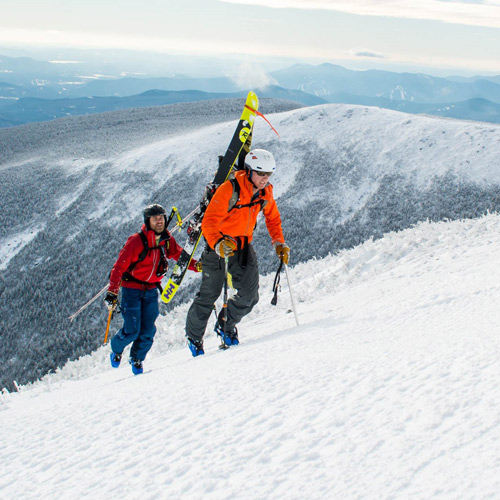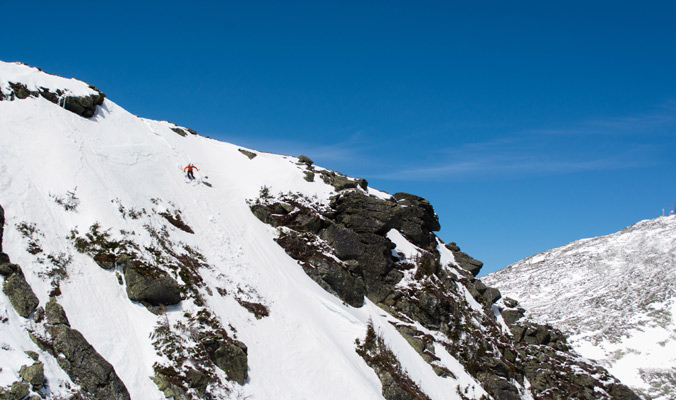In recent years, backcountry alliances have gained momentum as a popular vehicle for advocacy in the skiing world. These organizations are effective, central lobbying voices for recreational interests and also serve as a go-between for government agencies and private landholders. In Vermont, one such organization—the Vermont Backcountry Alliance—has taken root, and its next door neighbor, New Hampshire, took note and jumped on the alliance bandwagon.
New Hampshire boasts one of the oldest backcountry cultures in the country, but other than the popular Mt. Washington area, the state’s potential is largely untapped. The Granite Backcountry Alliance (GBA) seeks to change that.
We spoke with GBA President Tyler Ray to learn more about his vision for New Hampshire’s recreation future. Here is what he had to say.
![Tyler adn Colin Wroblewski ascend Gulf of Slides on Mt. Washington. [Photo] Tyler Ray](http://backcountrymagazine.com/wp-content/uploads/2016/11/granite_embed_1.jpg)
Tyler Ray and Colin Wroblewski ascend Gulf of Slides on Mt. Washington. [Photo] Christopher McKay
Tyler Ray: We were sitting here, in New Hampshire, looking over at Vermont and watching the incredible progress being made with the public land effort by The Rochester Area Sports Trail Alliance (RASTA), the Vermont Backcountry Alliance (VTBC) and the Catamount Trail Association (CTA). And we thought to ourselves, “Wait a minute. What’s happening here? Why isn’t anyone stepping up for New Hampshire or Maine?”
We have our own signature type skiing, but nothing is being done. We are seeing significant increase in user traffic, and an increase in illegal cuts that have happened. Then there is the effort over in Vermont, where they’ve laid out the blueprint for moving forward. We decided to put a team together to fill this need and see if we can make some progress.
BCM: How would you describe your relationship moving forward with other ski groups like the Friends of Tuckerman’s Ravine?
TR: We’ve approached many of those folks early on to chat about the backcountry landscape. The president of the Friends of Tuckerman’s Ravine (FoTR) is on our board. We consider ourselves complementary players, and we’re taking a big picture approach with our footprint being New Hampshire and Western Maine, whereas a group like FoTR is focused on the eastern slope of Mt. Washington specifically.
We are excited about the prospect of working together. In fact, we are even in discussions with FoTR being an initial pilot chapter of the Granite Backcountry Alliance. So, those conversations are ongoing, and the chapter structure is where we are headed. But right now, we are in our infancy; establishing our contacts and relationships, and seeing where we can grow from here.

Tyler Ray gets deep even on a low snow year. [Photo] Christopher McKay
TR: We see ourselves reconnecting with skiing’s past. One of our main objectives is to revive certain Civilian Conservation Corps (CCC) legacy trails. Over 60 trails in New Hampshire were cut by the CCC. Many of which were abandoned, donated to father time. There is only a handful that are still managed.
Historically, you have local ski clubs that would apply for labor with the CCC, then the CCC would come to town and cut a ski trail. Similarly, we think it’s important to localize efforts in different areas—or so called chapters—because that’s where the relationships are, that’s where things really happen. In some ways, we are taking the model back to the 1930s, just putting a modern flair to it, and hoping that we have interest.
BCM: What’s the level of interest in smaller communities for this project?
TR: Whether we can generate enough interest in local areas is still an unknown. Historically, you have great groups and outing clubs scattered across New Hampshire and Maine. Now that backcountry skiing is back on the table, we are hoping that folks will rediscover the sport.
BCM: With so many new and unfamiliar zones, how will your organization facilitate effective emergency protocol?
TR: This is one of the core issues of what we are up against. Currently skiing is unmanaged use. Right now it’s a bit like the Wild West. We want to encourage users to use glade zones. Part of our discussion with the Forest Service is to come up with a management plan, so we have a better handle on where people are going. This ties into the educational and safety component that we want to build.

Tyler Ray and Colin Wroblewski gain the ridge in Gulf of Slides, Mt. Washington. [Photo] Christopher McKay
TR: We like to think of ourselves as a group that advocates for low impact, human powered skiing and riding. The point is to not only establish additional terrain to disperse the activity, but also [communicate] with snowmobilers, hikers, all those groups; that is where the partnership level comes in. Part of the alliance is not just pulling together different chapters and individual members, but it is also establishing relationships with other groups and they may be stakeholders like snowmobilers.
BCM: What is your strategy for revitalizing CCC trails?
TR: The strategy is to identify and select certain trails that have the aspect and elevation that holds good snow, in an area that has access to parking and legal access to trails. We are also building partnerships with different groups. So, for example, we’ve been in talks with the Mt. Washington Auto Road. The Auto Road has been around for 155 years, and the ski trails were cut 80 years ago. They think the idea of resurrecting trails fits well with their model.
When we look at revitalizing CCC trails, we are looking to see what works with the habitat, wildlife and ecological impact on an area, and we will go through the same impact analysis as with any other request that goes through the Forest Service. We’d like to take a modern glading approach. We spoke with the trail designer for all the Rochester trails, and we will try and bring him on board due to his experience with trail building and with the Forest Service.
The CCC trails that we do select will be part of a broader zone. Think about how the Brandon Gap area is made of maybe three to four mountains. We are looking to do the same thing. We want to build a network of trails that may hook into Nordic ski trails or campgrounds or Appalachian Mountain Club huts.

Tyler Ray skis the summit cone of Mt. Washington in January 2016. [Photo] Christopher McKay
TR: From a resource perspective, we will have trail maps online and the ability to understand what the terrain is. Here in New Hampshire, it’s different from Vermont. We are blessed with the high alpine of the Presidential Range. We have above-treeline skiing with lots of gullies, steeps and bowls with lot of consequential zones. One of the reasons we are really trying to put forth this effort is to create a below treeline network of skiing, which currently only exists in a very limited fashion. That would entail different trails for different abilities and skills. It’s important to not only disperse folks, but segment terrain in a way that fits with a person’s ability level.
We don’t want someone’s first backcountry experience to be climbing up Tuckerman Ravine and making a turn on a 50-degree slope. You know how that’s going to end up right? And that’s why Tuckerman’s is a circus atmosphere at times. But just from a safety perspective too, when the winds are high, the avalanche danger is high. We want to create some other options to mitigate the risks of the high alpine. Going back to resources: trail maps, trail signs—we would like to develop a backcountry skier responsibility code and a Leave No Trace ethic.

Tyler Ray dives into Dodges Drop on Mt. Washington. [Photo] Christopher McKay
TR: On the East Coast, we suffer from tree density and weather variation. Our goal is to provide expanded terrain options, so we can enjoy the great mountain landscape we have. A lot of it harkens back to an article that you guys published on different backcountry alliances. One of the first things we did was to affiliate with the Winter Wildlands Alliance, and they’ve been a great resource for us already. We are looking to a neighbor [Vermont] who has gone through this process for guidance.
We hope to be the unified voice for backcountry skiers in N.H. and Western Maine. Not as a gatekeeper, but to have a seat at the table when developing stewardship plans, reviewing forest plans and other land agreements. We can be the intermediary between skiers and land managers. We’ve found the White Mountain National Forest to be very receptive to this approach—as they have been with other user groups like mountain biking—when attempting to manage a use that has previously been unmanaged.
—
Find more information on the Granite Backcountry Alliance at winterwildlands.org/graniteBC.











Related posts: